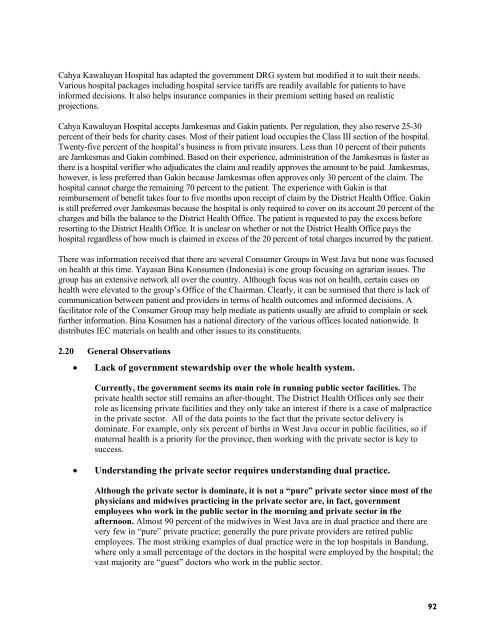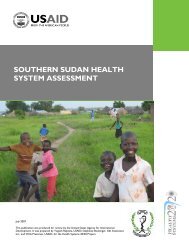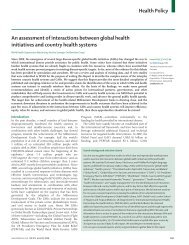PRIVATE SECTOR HEALTH CARE IN INDONESIA - Health Systems ...
PRIVATE SECTOR HEALTH CARE IN INDONESIA - Health Systems ...
PRIVATE SECTOR HEALTH CARE IN INDONESIA - Health Systems ...
- No tags were found...
You also want an ePaper? Increase the reach of your titles
YUMPU automatically turns print PDFs into web optimized ePapers that Google loves.
Cahya Kawaluyan Hospital has adapted the government DRG system but modified it to suit their needs.Various hospital packages including hospital service tariffs are readily available for patients to haveinformed decisions. It also helps insurance companies in their premium setting based on realisticprojections.Cahya Kawaluyan Hospital accepts Jamkesmas and Gakin patients. Per regulation, they also reserve 25-30percent of their beds for charity cases. Most of their patient load occupies the Class III section of the hospital.Twenty-five percent of the hospital’s business is from private insurers. Less than 10 percent of their patientsare Jamkesmas and Gakin combined. Based on their experience, administration of the Jamkesmas is faster asthere is a hospital verifier who adjudicates the claim and readily approves the amount to be paid. Jamkesmas,however, is less preferred than Gakin because Jamkesmas often approves only 30 percent of the claim. Thehospital cannot charge the remaining 70 percent to the patient. The experience with Gakin is thatreimbursement of benefit takes four to five months upon receipt of claim by the District <strong>Health</strong> Office. Gakinis still preferred over Jamkesmas because the hospital is only required to cover on its account 20 percent of thecharges and bills the balance to the District <strong>Health</strong> Office. The patient is requested to pay the excess beforeresorting to the District <strong>Health</strong> Office. It is unclear on whether or not the District <strong>Health</strong> Office pays thehospital regardless of how much is claimed in excess of the 20 percent of total charges incurred by the patient.There was information received that there are several Consumer Groups in West Java but none was focusedon health at this time. Yayasan Bina Konsumen (Indonesia) is one group focusing on agrarian issues. Thegroup has an extensive network all over the country. Although focus was not on health, certain cases onhealth were elevated to the group’s Office of the Chairman. Clearly, it can be surmised that there is lack ofcommunication between patient and providers in terms of health outcomes and informed decisions. Afacilitator role of the Consumer Group may help mediate as patients usually are afraid to complain or seekfurther information. Bina Kosumen has a national directory of the various offices located nationwide. Itdistributes IEC materials on health and other issues to its constituents.2.20 General Observations• Lack of government stewardship over the whole health system.Currently, the government seems its main role in running public sector facilities. Theprivate health sector still remains an after-thought. The District <strong>Health</strong> Offices only see theirrole as licensing private facilities and they only take an interest if there is a case of malpracticein the private sector. All of the data points to the fact that the private sector delivery isdominate. For example, only six percent of births in West Java occur in public facilities, so ifmaternal health is a priority for the province, then working with the private sector is key tosuccess.• Understanding the private sector requires understanding dual practice.Although the private sector is dominate, it is not a “pure” private sector since most of thephysicians and midwives practicing in the private sector are, in fact, governmentemployees who work in the public sector in the morning and private sector in theafternoon. Almost 90 percent of the midwives in West Java are in dual practice and there arevery few in “pure” private practice; generally the pure private providers are retired publicemployees. The most striking examples of dual practice were in the top hospitals in Bandung,where only a small percentage of the doctors in the hospital were employed by the hospital; thevast majority are “guest” doctors who work in the public sector.92
















